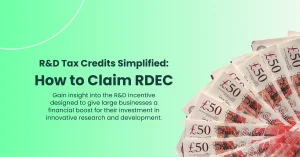Understanding R&D Tax Credits: How Far Back Can I Claim?

Don’t run out the clock on your R&D claim, instead, understand how you can form a compliant claim that awards you significant financial benefits. Examine the facts about R&D tax credits, the time constraints imposed by HMRC, and follow our 3 step process to prepare your claim.
When it comes to R&D tax credits, timing is crucial. Not only do HMRC set time limits for first time claimants, but each claim must adhere to specific deadlines in accordance with their own accounting period.
When seeking out information on these deadlines, the language can sometimes seem a little complicated however. So instead of spending hours trying to make sense of the government guidelines, we’ve simplified the material to present you with a direct insight into the time limits and deadlines that you need to know.
Understanding R&D Tax Credits
After its introduction in 2000, the R&D tax credit incentive has empowered businesses throughout the UK to invest in innovation. Initially the incentive was available only to small and medium sized enterprises (SMEs), but as of 2002 opened up to large companies, forming two primary R&D schemes:
- SME scheme
Available for businesses with fewer than 500 employees and either an annual turnover under €100 million, or a balance sheet under €86 million - RDEC
Available to large companies with 500+ employees and SMEs with subcontracted R&D that doesn’t meet specific qualifying criteria under the SME scheme
To qualify for R&D tax credits, projects must align with HMRC’s definition of research and development. That is to say that qualifying research and development projects should aim to achieve an advancement in science or technology by resolving a technical uncertainty that could not be overcome by an expert in the field.
2025 Update: ERIS and the Merged Scheme
In April 2024, HMRC introduced two new schemes with the aim of simplifying the R&D tax credit claims process. The new R&D tax credit schemes are:
- ERIS
Available for R&D intensive SMEs operating at a loss - The Merged Scheme
For all other businesses claiming R&D tax relief, regardless of their size or annual turnover
As both of these schemes are designed to make it easier for businesses to claim R&D tax relief, they will be taking over pre-existing schemes. This means that every claim with an accounting year that begins on or after April 1st 2024 will operate under either ERIS or the merged scheme.
Time Limits for Claiming R&D Tax Credits
The deadline for claiming R&D tax credits is two years after the end of the accounting period in which your project took place. This means that if your business did qualifying research and development in an accounting year that ended in July 2023, you have until July 2025 to make your R&D claim.
However, there are a couple of other deadlines that you need to be aware of when it comes to the tax relief.
Other R&D Deadlines to Note
Firstly, you need to understand the claim notification deadline. Businesses looking to make a claim must notify HMRC of their intention to claim R&D tax credits if:
- They have not claimed R&D tax relief in the previous three years.
- They are claiming for the first time
Your claim notification period starts on the first day of your business’s accounting period, and lasts until six months after the end of the accounting period. For a clearer picture of claim notification deadlines, scroll down to the example of R&D tax credit time limits.
Secondly, you have to understand the time limits involved in claiming the tax relief. Aligning with the deadline for a corporate tax return (CT600), the time limit for claiming R&D tax credits is two years from the end of the accounting period during which the research and development project occurred.
Example of R&D Tax Credit Time Limits
In order to simplify the time limits for claiming R&D tax credits, we wanted to provide a visual representation of accounting periods, so the following table highlights examples of accounting period end dates, their claim notification deadline, and the final deadline for their R&D claim.

3 Ways to Prepare Your R&D Tax Credit Claim
When looking to make an R&D tax credit claim, there are a few things that you should prepare beforehand in order to maximise the financial benefit of your claim. We’ve broken down what you should prepare into these 3 simple steps.
Step One: Identify Your Qualifying Factors
Before making your claim, you must first establish your qualifying activities. These are the actions that you took throughout your project in order to overcome the identified uncertainties, and that adhere to the following criteria:
- Activity should aim to advance knowledge or capability
- Activity must seek to resolve industry related uncertainties
- Activity should be conducted using a systematic approach
- Activity should not be easily replicated
Prior to identifying your qualifying activities, you’re required to identify the qualifying expenditure associated with each activity. These costs include:
- Direct staff costs (such as PAYE, NIC and pension contributions)
- Consumable item costs
- Software used directly in R&D
- Test stage prototype costs
By identifying the qualifying factors in this order, you may be able to maximise the extent of the financial benefits received from R&D tax credits.
Step Two: Gathering Documentation
Your documentation is what certifies your R&D claim. The documents that you gather should be able to present a timeline of your project, and certify your qualifying expenditure, some of which include:
- Project reports
- Employee time sheets
- R&D related financial reports
Step Three: Organising Your R&D Claim for Each Accounting Period
Many research and development projects span across a variety of years, necessitating more than one claim. For this reason, it is imperative that you organise your project documentation for each accounting period.
By organising your claim for each accounting period, not only will you be able to make the claims process more efficient, but you’ll also be able to prepare for any potential HMRC enquiries.
How Alexander Clifford Can Further Maximise Your Claim
As one of the leading R&D tax credit advisories, our team of specialists are known for their deep understanding of HMRC policy that helps businesses compile compliant R&D claims.
We’re here to guide you through the claims process, making sure no qualifying activity or cost goes unnoticed. Our dedicated specialists have already helped clients secure over £83 million in tax credit benefits by spotting opportunities others often miss.
That’s why Alexander Clifford is your trusted choice for R&D tax credits.
Ready to get started? Fill in the contact form below or book an appointment at a time that works for you.
Get a decision on your R&D eligibility from a qualified specialist in 15 minutes.







